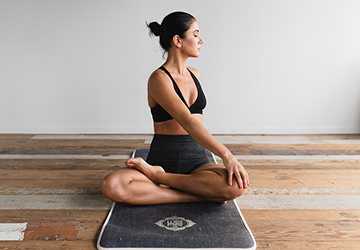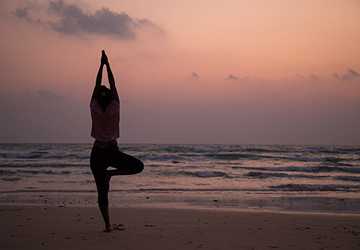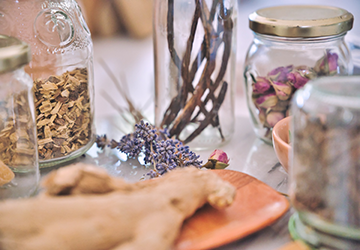How to Combine Yoga & Meditation for a Balanced Life?
Author: khawarabassi
Finding balance and inner peace can feel daunting in today's fast-paced world. We often juggle multiple responsibilities, leaving us feeling overwhelmed and stressed.
But what if there was a way to achieve balance and tranquility amidst the chaos? Enter yoga and meditation, two ancient practices have been proven to help reduce stress, increase mindfulness, and improve overall well-being.
This blog post will explore how to effectively combine yoga and meditation to create a holistic approach to maintaining balance. By incorporating both practices into your daily routine, you'll be well on your course to achieving a more balanced and centered life.
So, let's dive into yoga and meditation and discover the key to inner harmony!

Understanding the Connection between Yoga and Meditation
Yoga and meditation share a common goal: to promote inner peace and balance. Yoga, an ancient practice originating in India, focuses on physical postures, breathing techniques, and mental concentration.
It helps increase flexibility, strength, and mindfulness. Meditation, on the other hand, is a mental practice that encourages focused attention and deep relaxation.
Combining these two practices can create a synergistic approach to achieving balance in your life.
The physical postures in yoga can help prepare the body for meditation, while the mental focus and relaxation techniques in meditation can enhance the benefits of your yoga practice.
Choose a Style of Yoga That Complements Meditation
There are various styles of yoga, each with its unique focus and intensity. When combining yoga and meditation, choosing a style that emphasizes mindfulness and relaxation is essential.
Some well-suited yoga styles for meditation include Hatha, Yin, and Restorative yoga. These styles tend to have slower-paced movements and longer-held poses, encouraging mindfulness and a deeper connection to the breath.
Experiment with different styles to find one that resonates with you and helps you cultivate a meditative state.
Develop a Consistent Routine
Consistency is critical to reaping the benefits of yoga and meditation. Aim to practice both days, even if it's just for a few minutes. Establishing a routine can help create a sense of stability and balance in your life.
One approach is to begin your day with a gentle yoga practice and meditation. This can help set a positive tone for the day ahead and encourage mindfulness throughout your daily activities.
Alternatively, you could practice yoga and meditation in the evening to unwind from the day and promote restful sleep. Experiment with different times to find what works best for you.
Create a Dedicated Space
A dedicated space for your yoga and meditation practice can help create a sense of ritual and intention. This doesn't have to be an elaborate setup; it can be as simple as a quiet corner of your home with a yoga mat and meditation cushion.
Consider adding elements that promote a sense of calm and serenity, such as candles, soft lighting, or soothing music. Creating a welcoming and comfortable environment can help you look forward to your practice and encourage consistency.
Integrate Breathwork into Both Practices
Breathwork is an essential aspect of both yoga and meditation. In yoga, coordinating your breath with movement can deepen your practice and increase your focus. In meditation, focusing on your breath can help anchor your attention and promote relaxation.
Experiment with different breathing techniques, such as diaphragmatic or alternate nostril breathing, and incorporate them into your yoga and meditation practices.
Developing a solid connection to your breath can cultivate greater mindfulness and presence in both disciplines.

Mindfulness in Movement
While meditation often involves sitting still, you can also practice mindfulness during your yoga practice. As you move through various poses, bring your full attention to each movement and sensation in your body, and this can help create a sense of presence and awareness in your meditation practice.
When practicing mindfulness in movement, focus on the quality of each movement rather than striving for perfection in each pose. This approach can help you develop a more compassionate and non-judgmental attitude toward your body and practice.
Use Guided Meditations and Yoga Nidra
If you're new to meditation or find it challenging to quiet your mind, consider using guided meditations or Yoga Nidra to help you relax and focus.
Guided meditations are audio recordings that provide step-by-step instructions to help you enter a meditative state. Yoga Nidra, also known as "yogic sleep," is a form of guided relaxation that encourages deep rest and healing.
Many resources are available online, including apps, podcasts, and websites that offer guided meditations and Yoga Nidra recordings. Experiment with different guides and styles to find what resonates with you.
Attend Workshops and Retreats
Attending workshops and retreats that combine yoga and meditation can provide valuable guidance, inspiration, and support.
These events often bring together like-minded individuals and experienced instructors who can help deepen your understanding and practice of both disciplines.
Retreats can range from weekend getaways to week-long immersive experiences. They often take place in serene locations that encourage relaxation and self-reflection.
By dedicating time to focus on your yoga and meditation practice, you can fully integrate these practices into your daily life.
Be Patient and Compassionate with Yourself
It would be best to approach your yoga and meditation practice with patience and self-compassion. Both disciplines require time, dedication, and consistent effort to see progress.
Remember that the journey is more important than the destination, and any amount of practice is beneficial.
When you encounter challenges or setbacks, treat yourself with kindness and understanding. Remember that growth often comes from overcoming obstacles and embracing the ups and downs is part of a balanced life.
Seek Support from a Community
Connecting with others who share your interest in yoga and meditation can provide valuable support and encouragement.
Consider joining a local yoga studio, meditation group, or online community to share your experiences, learn from others, and stay motivated in your practice.
Engaging with a community can also provide new outlooks and insights to help you grow and deepen your understanding of yoga and meditation. Remember that we're all on our unique journey; learning from one another can enrich our path toward balance and inner peace.
Conclusion
Combining powerful yoga and meditation practices can create a holistic approach to balance and harmony. With consistent practice, a dedicated space, and a supportive community, you'll be well on your way to cultivating inner peace and well-being.
Remember to be patient with yourself and approach your practice with an open heart and mind. Embrace the journey and the lessons it offers, and you'll find that the path to a balanced life lies within the powerful union of yoga and meditation. Now it's time to roll out your mat, close your eyes, and embark on your journey toward balance and inner harmony.



